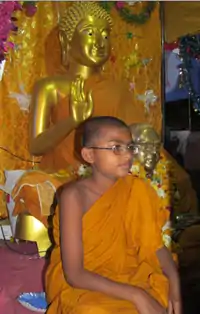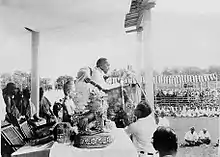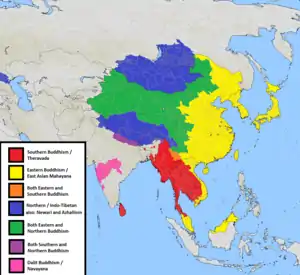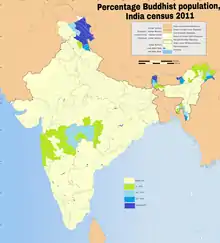Navayana
Navayana (Devanagari: नवयान, IAST: Navayāna) means "new vehicle" and refers to the re-interpretation of Buddhism by B. R. Ambedkar.[1][2] Ambedkar was born in a Dalit (untouchable) family during the colonial era of India, studied abroad, became a Dalit leader, and announced in 1935 his intent to convert from Hinduism to Buddhism.[3] Thereafter Ambedkar studied texts of Buddhism, found several of its core beliefs and doctrines such as Four Noble Truths and "non-self" as flawed and pessimistic, then re-interpreted these into what he called "new vehicle" of Buddhism.[4] This is known as Navayana, also known as Bhimayāna, after Ambedkar's first name Bhimrao.[4] Ambedkar held a press conference on October 13, 1956, announcing his rejection of Theravada and Mahayana Buddhism, as well as of Hinduism.[5] Thereafter, he left Hinduism and adopted Navayana, about six weeks before his death.[1][4][5] Navayana Buddhism is not a sect with radically different ideas, but a new movement from the same principles of Buddhism.
.jpg.webp)
| Part of a series on |
| Buddhism |
|---|
 |
|

In the Dalit Buddhist movement of India, Navayana is considered a new branch of Buddhism, different from the traditionally recognized branches of Theravada, Mahayana and Vajrayana.[6] Navayana rejects many traditional interpretations of practices and precepts (such as renouncing monasticism, karma, rebirth in an afterlife, samsara, meditation, enlightenment and the Four Noble Truths) considered to be foundational in the Buddhist traditions.[7] It radically re-interprets what Buddhism is,[8] revising the original Buddha teaching to be about class struggle and social equality.[4][9][10]
Ambedkar called his version of Buddhism Navayana or Neo-Buddhism.[11] His book, The Buddha and His Dhamma is the holy book of Navayana followers. Followers of Navayana Buddhism are generally called "Buddhists" (Baud'dha) as well as "Ambedkarite Buddhists", "Neo-Buddhists", and rarely called "Navayana Buddhists".[12]
Origins

Ambedkar was an Indian leader influential during the colonial era and the early post-independence period of India. He was the fourteenth child in an impoverished Maharashtra Dalit family, who studied abroad, returned to India in the 1920s and joined the political movement. His focus was social and political rights for the Dalits.[13] To free his community from religious prejudice, he concluded that they must leave Hinduism and convert to another religion. He chose Buddhism in the form of Navayana.[13][9]
Doctrines and concepts
In 1935, during his disagreements with Mahatma Gandhi, Ambedkar announced his intent to convert from Hinduism to Buddhism.[3] Over the next two decades, Ambedkar studied texts of Buddhism and wrote his text, The Buddha and His Dhamma, which is the primary doctrine of those who follow Navayana Buddhism.[14]
- Core Beliefs
In his unpublished editorial of the founding text of the Navayana, Ambedkar writes:
To disarm all criticism I would like to make it clear that I claim no originality for the book. It is a compilation and assembly plant. The material has been gathered from various books. I would particularly like to mention Ashvaghosha's Buddhavita, whose poetry no one can excel. In the narrative of certain events I have even borrowed his language.[15]
This indicates that Navayana Buddhism is not a sect with radically different ideas, but a new movement from the same principles of Buddhism.
He goes on further to say that his doctrine simplifies the teachings of Buddhism and clear up the various misconceptions and possible points of confusion people may have about the faith. He explains, "The only originality that I can claim in is the order of presentation of the topics, in which I have tried to introduce simplicity and clarity. There are certain matters which give headaches to the student of Buddhism."
In his essay, "Buddha and the Future of His Religion," Ambedkar mentions that the only major faith compatible with Science is Buddhism. He compares Jesus, Prophet Muhammed and Krishna to the Buddha, and mentions that while Jesus called himself the "son of god," Prophet Muhammad called himself the "messenger of god" and Krishna called himself the "Parameswhar," i.e. god of gods, Buddha was "born as a son of man and was content to remain a common man and preached his gospel as a common man. He never claimed any supernatural origin or supernatural powers nor did he perform miracles to prove his supernatural powers."[16]
In addition, he states, that Buddhism is one of the few religions that do not claim their values are derived from God, and are therefore innately flexible and capable of withstanding Modernism. Ambedkar writes in the same essay:
the Buddha claimed no such infallibility for what he taught. In the Mahaparinibbana Sutta He told Ananda that His religion was based on reason and experience and that his followers should not accept his teaching as correct and binding merely because they emanated from Him. Being based on reason and experience they were free to modify or even to abandon any of his teachings if it was found that at a given time and in given circumstances they do not apply.
- Buddhist Karma and its misrepresentation by Hindus
One of the major misunderstandings that Ambedkar sought to clear about Buddhism was that of Karma and Anatta, and a seeming contradiction between the philosophies. Based on this, many believed Buddhism is very similar to Hinduism on the account of there being Karma and rebirth in both faiths. On this, Ambedkar made it very clear that these are very different philosophies. "Ignorant Hindus, out of sheer want of understanding, say by comparing merely the similarity of words, that Buddhism is the same as Brahmanism or Hinduism," he reasons, "The Hindu Law of Karma is based on the soul. The Buddhist is not. In fact, there is no soul in Buddhism." referring to the Buddhist doctrine of Anatta, or no soul.
Therefore, he reasons, the Karma in Buddhism is a moral philosophy based only on actions of one's immediate life, such that an individual is not rendered helpless. He argues that a karma based on previous life is a dangerous ideology, because "for in this interpretation of karma there is no room left for human effort. Everything is predetermined for him by his past karma."
He also claims that inherited Karma is a blatantly anti-scientific concept, arguing, "According to science, a child inherits the characteristics of his parents. In the Hindu doctrine of karma a child inherits nothing from its parents except the body. The past karma in the Hindu doctrine is the inheritance of the child by the child and for the child. The parents contributes nothing. The child brings everything. Such a doctrine is nothing short of an absurdity. As shown above, the Buddha did not believe in such an absurdity." [17]
- Ambedkar's 22 vows
On converting to Buddhism, Ambedkar made 22 vows, and asked his supporters to do the same: [18]
- I shall have no faith in Brahma, Vishnu and Maheshwara, nor shall I worship them.
- I shall have no faith in Rama and Krishna, who are believed to be incarnation of God, nor shall I worship them.
- I shall have no faith in Gauri, Ganapati and other gods and goddesses of Hindus, nor shall I worship them.
- I do not believe in the incarnation of God.
- I do not and shall not believe that Lord Buddha was the incarnation of Vishnu. I believe this to be sheer madness and false propaganda.
- I shall not perform Shraddha nor shall I give pind.
- I shall not act in a manner violating the principles and teachings of the Buddha.
- I shall not allow any ceremonies to be performed by Brahmins.
- I shall believe in the equality of man.
- I shall endeavour to establish equality.
- I shall follow the Noble Eightfold Path of the Buddha.
- I shall follow the ten paramitas prescribed by the Buddha.
- I shall have compassion and loving-kindness for all living beings and protect them.
- I shall not steal.
- I shall not tell lies.
- I shall not commit carnal sins.
- I shall not take intoxicants like liquor, drugs, etc.
- (The previous five proscriptive vows [#13–17] are from the Five Precepts.)
- I shall endeavour to follow the Noble Eightfold Path and practice compassion and loving-kindness in everyday life.
- I renounce Hinduism, which disfavors humanity and impedes the advancement and development of humanity because it is based on inequality, and adopt Buddhism as my religion.
- I firmly believe the Dhamma of the Buddha is the only true religion.
- I consider that I have taken a new birth. (Alternately, "I believe that by adopting Buddhism I am having a re-birth."[19])
- I solemnly declare and affirm that I shall hereafter lead my life according to the teachings of Buddha's Dhamma.
These vows demonstrate the social movement side of Navayana Buddhism, and demonstrate its core deviation from earlier sects of Buddhism.
Conversion

Ambedkar re-interpreted Buddhism to address such issues in his mind, and re-formulated the traditional teachings of Buddhism into a "new vehicle" called Navayana.[1][4] Navayana dhamma doctrine as propounded by Ambedkar, states Yashwant Sumant, "does not situate morality in a transcendental [religious] domain", nor in "a civil association, including the state". Dhamma is derived from and the guiding principle for social conscience.[20]
Navayana Buddhism began in 1956, when B. R. Ambedkar adopted it, and 380,000 Dalit community members converted to Navayana from Hinduism on 14 and 15 October 1956.[13][5] After that on every year 14 October is celebrated as Dhammachakra Pravartan Day at Dikshabhoomi, Nagpur:
I will accept and follow the teachings of Buddha. I will keep my people away from the different opinions of Hinayana and Mahayana, two religious orders. Our Buddhism is a Neo-Buddhism, Navayana.
— Babasaheb Ambedkar, Press interview on 13 October 1956 at Sham Hotel, Nagpur[21]
Scripture and practice
The writings of Ambedkar were posthumously published as The Buddha and His Dhamma, and this is the scripture for those who follow Navayana Buddhism.[22] Among the Navayana followers, state Keown and Prebish, this is "often referred to as their 'bible' and its novel interpretation of the Buddhist path commonly constitutes their only source of knowledge on the subject.[9]
B. R. Ambedkar is regarded as a bodhisattva, the Maitreya, among the Navayana followers.[23][24] In practice, the Navayana followers revere Ambedkar, states Jim Deitrick, as virtually on par with the Buddha.[25] He is considered as the one prophesied to appear and teach the dhamma after it was forgotten; his iconography is a part of Navayana shrines and he is shown with a halo.[24] Though Ambedkar states Navayana to be atheist, Navayana viharas and shrines features images of the Buddha and Ambedkar, and the followers bow and offer prayers before them in practice.[26] According to Junghare, for the followers of Navayana, Ambedkar has become a deity and is devotionally worshipped.[27]
Reception
Ambedkar's re-interpretation of Buddhism and his formulation of Navayana has attracted admirers and criticism.[10] The Navayana theories restate the core doctrines of Buddhism, according to Eleanor Zelliot, wherein Ambedkar's "social emphasis exclude or distort some teaching, fundamental to traditional and canonical Buddhism".[28] Anne Blackburn states that Ambedkar re-interprets core concepts of Buddhism in class conflict terms, where nirvana is not the aim and end of spiritual pursuits, but a preparation for social action against inequality:
Ambedkar understands the Buddha's teaching that everything is characterized by Dukkha, or unsatisfactoriness, as referring specifically to interpersonal relations. In one instance Ambedkar presents a dialogue in which the Buddha teaches that the root of dukkha is class conflict and asserts elsewhere that "the Buddha's conception of Dukkha is material." Nibbana (Skt. nirvana) the state or process which describes enlightenment, is considered [by Ambedkar] a precursor for moral action in the world and explicitly associated with a non-monastic lifestyle. Nibbana "means enough control over passion so as to enable one to walk on the path of righteousness." Ambedkar's interpretation of dukkha and nibbana implies that moral action, for which nibbana is preparation, will rectify the material suffering of inequality.
— Anne Blackburn, Religion, Kinship and Buddhism: Ambedkar's Vision of a Moral Community[10]
Ambedkar considered all ideas in Theravada and Mahayana Buddhism that relate to an individual's merit and spiritual development as insertions into Buddhism, and something that "cannot be accepted to be the word of the Buddha". Buddhism, to Ambedkar, must have been a social reform movement.[10][28] Martin Fuchs states that Ambedkar's effort is to be admired as an attempt to seek a "post-religious religion" which transcends distinctions and as being driven by the "reasonable principle of sociality", not in the sense of spiritual doctrines, philosophical speculations and existentialist questions.[29]
According to Blackburn, "neither view of traditional Buddhism — as a social reform movement or as some other stable entity interpreted (or misinterpreted) from a social reform perspective — is historically accurate", thereby placing Navayana theories to be ahistorical though it served as an important means to Dalit political mobilization and social movement.[10] Scholars broadly accept that the depictions of the Buddha as a caste or social reformer are inaccurate.[10][30] Richard Gombrich, an Indologist and a professor of Buddhist Studies, states that there is no evidence that the Buddha began or pursued social reforms or was against a caste system, rather his aim was at the salvation of those who joined his monastic order.[31][32][33] Modernist interpreters of Buddhism, states Gombrich, keep picking up this "mistake from western authors", a view that initially came into vogue during the colonial era.[31][34][35] Empirical evidence outside of India, such as in the Theravada Buddhist monasteries of the Sinhalese society, suggests that caste ideas have been prevalent among the sangha monks, and between the Buddhist monks and the laity. In all canonical Buddhist texts, the kshatriyas (warrior caste) are always mentioned first and never other classes such as brahmins, vaishyas, shudras or the untouchables.[36]
The novel interpretations and the dismissal of mainstream doctrines of Buddhism by Ambedkar as he formulated Navayana has led some to suggest that Navayana may more properly be called Ambedkarism.[9] However, Ambedkar did not consider himself as the originator of a new Buddhism, but stated that he was merely reviving what was original Buddhism after centuries of "misguided interpretation" by wrong headed Buddhist monks.[9] Others, states Skaria, consider Ambedkar attempting a synthesis of the ideas of modern Karl Marx into the structure of ideas by the ancient Buddha, as Ambedkar worked on essays on both in the final years of his life.[37]
According to Janet Contursi, Ambedkar re-interprets Buddhist religion and with Navayana "speaks through Gautama and politicizes the Buddha philosophy as he theologizes his own political views".[38]
Status in India


According to the 2011 Census of India there are 8.4 million Buddhists in India. Navayana Buddhists comprise about 87% (7.3 million) of Indian Buddhist community, and nearly 90% (6.5 million) of all Navayana Buddhists in India live in Maharashtra state.[40] A 2017 IndiaSpend.com report on census data says "Buddhists have a literacy rate of 81.29%, higher than the national average of 72.98%", but it does not distinguish Navayana Buddhists from other Buddhists. When compared to overall literacy rate of Maharashtra state where 80% of Buddhists are found, their literacy rate is 83.17% or slightly higher than statewide average of 82.34%.
According to Jean Darian, the conversion to Buddhism and its growth in India has in part been because of non-religious factors, in particular the political and economic needs of the community as well as the needs of the political leaders and the expanding administrative structure in India.[41] According to Trevor Ling and Steven Axelrod, the intellectual and political side of Navayana Buddhist movement lost traction after the death of Ambedkar.[42]
Festivals
Ambedkar Jayanti, Dhammachakra Pravartan Day and Buddha's Birthday, Constitution Day of India are four major festivals of Navayana Buddhists.
See also
References
- Gary Tartakov (2003). Rowena Robinson (ed.). Religious Conversion in India: Modes, Motivations, and Meanings. Oxford University Press. pp. 192–213. ISBN 978-0-19-566329-7.
- Christopher Queen (2015). Steven M. Emmanuel (ed.). A Companion to Buddhist Philosophy. John Wiley & Sons. pp. 524–525. ISBN 978-1-119-14466-3.
- Nicholas B. Dirks (2011). Castes of Mind: Colonialism and the Making of Modern India. Princeton University Press. pp. 267–274. ISBN 978-1-4008-4094-6.
- Eleanor Zelliot (2015). Knut A. Jacobsen (ed.). Routledge Handbook of Contemporary India. Taylor & Francis. pp. 13, 361–370. ISBN 978-1-317-40357-9.
- Christopher Queen (2015). Steven M. Emmanuel (ed.). A Companion to Buddhist Philosophy. John Wiley & Sons. pp. 524–529. ISBN 978-1-119-14466-3.
- Omvedt, Gail. Buddhism in India : Challenging Brahmanism and Caste. 3rd ed. London/New Delhi/Thousand Oaks: Sage, 2003. pages: 2, 3–7, 8, 14–15, 19, 240, 266, 271
- Damien Keown; Charles S. Prebish (2013). Encyclopedia of Buddhism. Routledge. p. 25. ISBN 978-1-136-98588-1., Quote: "(...)The Buddhism upon which he settled and about which he wrote in The Buddha and His Dhamma was, in many respects, unlike any form of Buddhism that had hitherto arisen within the tradition. Gone, for instance, were the doctrines of karma and rebirth, the traditional emphasis on renunciation of the world, the practice of meditation, and the experience of enlightenment. Gone too were any teachings that implied the existence of a trans-empirical realm (...). Most jarring, perhaps, especially among more traditional Buddhists, was the absence of the Four Noble Truths, which Ambedkar regarded as the invention of wrong-headed monks".
- Bruce Rich (2008). To Uphold the World. Penguin Books. p. 204. ISBN 978-0-670-99946-0., Quote: Ambedkar's interpretation of Buddhism was a radical one; it took a revisionist approach to a number of widely accepted traditional Buddhist teachings".
- Damien Keown; Charles S. Prebish (2013). Encyclopedia of Buddhism. Routledge. pp. 24–26. ISBN 978-1-136-98588-1.
- Anne M. Blackburn (1993), Religion, Kinship and Buddhism: Ambedkar's Vision of a Moral Community, The Journal of the International Association of Buddhist Studies 16 (1), 1–22
- Christopher S. Queen (2000). Engaged Buddhism in the West. Wisdom Publications. p. 23. ISBN 978-0-86171-159-8.
- Christopher Queen (2015). Steven M. Emmanuel (ed.). A Companion to Buddhist Philosophy. John Wiley & Sons. pp. 524–531. ISBN 978-1-119-14466-3.
- Robert E. Buswell Jr.; Donald S. Lopez Jr. (2013). The Princeton Dictionary of Buddhism. Princeton University Press. p. 34. ISBN 978-1-4008-4805-8.
- Christopher Queen (2015). Steven M. Emmanuel (ed.). A Companion to Buddhist Philosophy. John Wiley & Sons. pp. 529–531. ISBN 978-1-119-14466-3.
- B.R. Ambedkar. Frances W. Pritchett (ed.). The Buddha and His Dhamma.
- Ambedkar, B.R. "The Buddha and the Future of His Religion". drambedkarbooks.com. Retrieved 12 September 2020.
- B.R. Ambedkar. Frances W. Pritchett (ed.). The Buddha and His Dhamma.
- Omvedt, Gail (2003). Buddhism in india : challenging Brahmanism and caste. Thousand Oaks, CA: Sage Publications. pp. 261–262. ISBN 0761996648.
- http://www.jaibheem.com/22%20Vows.htm
- Yashwant Sumant (2004). Surendra Jondhale; Johannes Beltz (eds.). Reconstructing the World: B.R. Ambedkar and Buddhism in India. Oxford University Press. pp. 74–75. ISBN 978-0-19-566529-1.
- Navayan: Homeland of Ambedkarite Buddhism, Official Website
- Christopher Queen (2015). Steven M. Emmanuel (ed.). A Companion to Buddhist Philosophy. John Wiley & Sons. pp. 529–531. ISBN 978-1-119-14466-3.
- Fitzgerald, Timothy (2003). The Ideology of Religious Studies. Oxford University Press. p. 129. ISBN 978-0-19-534715-9.
- M.B. Bose (2017). Tereza Kuldova and Mathew A. Varghese (ed.). Urban Utopias: Excess and Expulsion in Neoliberal South Asia. Springer. pp. 144–146. ISBN 978-3-319-47623-0.
- Jim Deitrick (2013). Damien Keown and Charles S. Prebish (ed.). Encyclopedia of Buddhism. Routledge. p. 25. ISBN 978-1-136-98588-1.
- Rowena Robinson (2003). Religious Conversion in India: Modes, Motivations, and Meanings. Oxford University Press. p. 2009. ISBN 978-0-19-566329-7.
- I.Y. Junghare (1988), Dr. Ambedkar: The Hero of the Mahars, Ex-Untouchables of India, Asian Folklore Studies, 47 (1), 93–121, "(...) the new literature of the Mahars and their making of the Ambedkar deity for their new religion, Neo-Buddhism. (...) Song five is clearly representative of the Mahar community's respect and devotion for Ambedkar. He has become their God and they worship him as the singer sings: "We worship Bhima, too." (...) In the last song, Dr. Ambedkar is raised from a deity to a supreme deity. He is omnipresent, omnipotent, and omniscient."
- Eleanor Zelliot and Joanna Rogers Macy (1980), Tradition and Innovation in Contemporary Indian Buddhism, in Ed: A.K. Narain, Studies in the History of Buddhism. Delhi: B.R. Publishing, pages 134–142
- Martin Fuchs (2001), "A religion for civil society? Ambedkar's Buddhism, the Dalit issue and the imagination of emergent possibilities", in Editors: Vasudha Dalmia, Angelika Malinar and Martin Christof, Charisma and Canon: Essays on the Religious History of the Indian Subcontinent, Oxford University Press, ISBN 978-01956-545-30, pages 250–273
- Y. Krishan (1986), Buddhism and the Caste System, The Journal of the International Association of Buddhist Studies 9 (1), 71–84, Quote: "It has been long recognised that Buddhism and Jainism were not movements for social reform directed against the caste system, and that the Buddha's doctrine did not aim at transformation or improvement of the social conditions."
- Richard Gombrich (2012). Buddhist Precept & Practice. Routledge. pp. 344–345, context and discussion: 343–370. ISBN 978-1-136-15623-6.
- Randall Collins, The Sociology of Philosophies: A Global Theory of Intellectual Change. Harvard University Press, 2000, page 205-206
- Christopher S. Queen; Sallie B. King (1996). Engaged Buddhism: Buddhist Liberation Movements in Asia. State University of New York Press. pp. 17–18. ISBN 978-0-7914-2844-3.
- Wanda Alberts (2007). Integrative Religious Education in Europe: A Study-of-Religions Approach. Walter de Gruyter. pp. 258–259. ISBN 978-3-11-097134-7.
- Donald S. Lopez Jr. (2009). Buddhism and Science: A Guide for the Perplexed. University of Chicago Press. pp. 84–91. ISBN 978-0-226-49324-4.
- Richard Gombrich (2012). Buddhist Precept & Practice. Routledge. pp. 343–366. ISBN 978-1-136-15623-6.
- Skaria, A. (2015). "Ambedkar, Marx and the Buddhist Question". Journal of South Asian Studies. Taylor & Francis. 38 (3): 450–465. doi:10.1080/00856401.2015.1049726.
- Contursi, Janet A. (1993). "Political Theology: Text and Practice in a Dalit Panther Community". The Journal of Asian Studies. Cambridge University Press. 52 (2): 320–339. doi:10.2307/2059650. JSTOR 2059650.
- "Manu Moudgil, Dalits Are Still Converting to Buddhism, but at a Dwindling Rate, The Quint, 17.06.17".
- Darian, Jean C. (1977). "Social and Economic Factors in the Rise of Buddhism". Sociological Analysis. Oxford University Press. 38 (3): 226–231. doi:10.2307/3709803. JSTOR 3709803.
- Trevor Ling; Steven Axelrod (1980). Buddhist Revival in India: Aspects of the Sociology of Buddhism. Palgrave Macmillan. pp. 49–51. ISBN 978-1-349-16310-6.
Further reading
- Ambedkar, BR (1950). "Buddha and the Future of His Religion". The Mahä-Bodhi. 58 (4–5): 117–118, 199–206.
- Ambedkar, Bhimrao Ramji; Rathore, Aakash Singh; Verma, Ajay (eds) (2011). The Buddha and his dhamma: a critical edition. Oxford University Press. ISBN 9780198068679.CS1 maint: extra text: authors list (link)
- Gannon, Shane P. (2011). "Conversion as a Thematic Site: Academic Representations of Ambedkar's Buddhist Turn". Method & Theory in the Study of Religion. 23 (1): 1–28. doi:10.1163/157006811X549670. JSTOR 23555728.
- Jondhale, Surendra; Beltz, Johannes (2004). Reconstructing the world: B.R. Ambedkar and Buddhism in India, New Delhi : Oxford University Press, ISBN 0195665295
- Singh, Aakash (2011). "The political theology of Navayana Buddhism", in: Péter Losonczi; Mika Luoma-aho; The Future of Political Theology: Religious and Theological Perspectives, Farnham, Surrey, England; Burlington, VT: Ashgate, pp. 159–172. ISBN 9781409417606
External links
| Wikimedia Commons has media related to Navayana. |
- P.J.C.L. van der Velde, "The Biography, 'Navayana' as the 'new Vehicle' and Upaya", Radboud University, The Netherlands Psychotherapy and Buddhism
- Byung-Jo Chung, "Navayāna Buddhism: A Fresh Direction for Buddhism to Reflect the New Millenium", International Journal of Buddhist Thought & Culture, (September 2003, Vol. 3).
